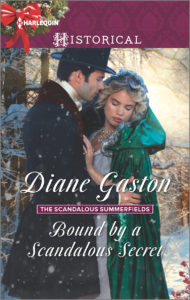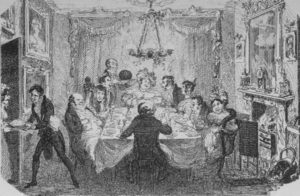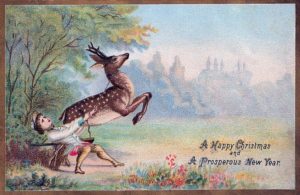 Bound By A Scandalous Secret, available in paperback and ebook, begins and ends in the Christmas season. I’ve written about Christmas before in A Twelfth Night Tale (my only Christmas novella, still available in the Governess Brides Bundle), but I had to go back and do the research about Christmas in the Regency all over again.
Bound By A Scandalous Secret, available in paperback and ebook, begins and ends in the Christmas season. I’ve written about Christmas before in A Twelfth Night Tale (my only Christmas novella, still available in the Governess Brides Bundle), but I had to go back and do the research about Christmas in the Regency all over again.
Many familiar Christmas traditions–decorating Christmas trees, singing Silent Night, waiting for Santa Claus–did not emerge until the later Victorian times, but a Regency Christmas did have other traditions still celebrated today.
Regency families decorated their houses with holly and ivy and evergreens of fir and pine. Mistletoe was hung and the tradition of a gentleman and lady kissing beneath it would have been part of a Regency Christmas. With each kiss the gentleman plucked a berry from the mistletoe. When the berries were gone, so were the kisses. In the book I’m working on now (more on that in later months) the hero and heroine decorate his house. I’m writing those scenes today!
Christmas was mainly a religious holiday during the Regency. Gifts were exchanged, church attended, and guests might be invited to Christmas dinner, like Ross and Dell were invited to Lord Tinmore’s for Christmas dinner in Bound By A Scandalous Night.
 At Christmas dinner a goose or turkey would be served. A Regency household would also serve a Christmas pudding that was made on Stir Up Sunday, the Sunday before Advent, and served on Christmas day. The pudding was a porridge of sugar, raisins, currants, prunes, and wine that was “stirred up” and boiled together in a pudding cloth.
At Christmas dinner a goose or turkey would be served. A Regency household would also serve a Christmas pudding that was made on Stir Up Sunday, the Sunday before Advent, and served on Christmas day. The pudding was a porridge of sugar, raisins, currants, prunes, and wine that was “stirred up” and boiled together in a pudding cloth.
Some of the traditions of the Regency holiday season had their origins in ancient winter celebrations. First-Footing customs of New Year’s Day may have originated in ancient Greece. In order to have good fortune all the year, an uninvited stranger–a dark man in some areas of the UK but the hair color could vary by region–should be the first to cross the threshold on New Years Day. He might carry symbolic gifts- salt (or a coin) for wealth; coal for warmth, a match for kindling, and bread for food. The householder might offer him food and drink. In some villages one tall, dark, and handsome fellow was selected to visit all the houses, receiving food and drink at each one. I mentioned this custom in A Twelfth Night Tale.
Twelfth Night, the eve of the Epiphany, was even more of a time for revelry than Christmas day during the Regency. It was a time to drink wassail (ale or wine spiced with roasted apples and sugar) and play games. A bean was buried in a cake and whoever found it was designated the Lord of Misrule who presided over all the Twelfth Night festivities, which might include theatricals or singing, although many of our most popular Christmas Carols were translated from German later in Victorian times. When Twelfth Night was over, the house decorations were removed and the season is over.
Christmas cards were invented by Sir Henry Cole, who, as an Assistant Keeper of what is now the Post Office in the UK, started the Penny Post, the first postal service that ordinary people could afford. He and an artist friend designed a Christmas card that would encourage people to use the Penny Post. Here’s an example of a Victorian Christmas Card.

It is rather fun to be writing Christmas scenes in this Christmas season. And to have a book out at this time of year where Christmas plays a part. Of course, though my characters are decorating at this very moment. I’ve not done anything yet!
Have you decorated for the holidays yet? Have you sent any Christmas cards?

Diane, congrats again on the new book. I haven’t done any holiday preparation yet. It seems like so many people put Christmas decorations up the day after Thanksgiving (even before, this year) but I’m too busy and also, spreading Christmas over too many weeks feels like it makes it less special. My exception is craft projects that need more lead time. But this is just me–everyone should do what works for them!
I love that Victorian Christmas card – how fascinating that the image they used isn’t wintry at all!
Somehow, I never find the time to decorate for the holidays (which has led my mum to suspect I might be a changeling, or at very least, switched at birth – LOL!) and this year, I haven’t even got around to baking Christmas cookies. (GAH!) My mum has started to decorate a couple of days ago. She has this cute china winter village, where the houses are all little lanterns. So cute! And each year, she also puts out an orchestra of little wooden angels with green wings (green wings with white polka dots). They all stand on a little shelf in the hallway of my parents’ flat, and they make me smile every time I pass them by. 🙂
Congrats again on the new book, Diane!
[…] Regency Christmas traditions. I’ve blogged about Regency Christmases before, like here at Risky Regencies in 2016, when Bound By a Scandalous Secret was a December […]